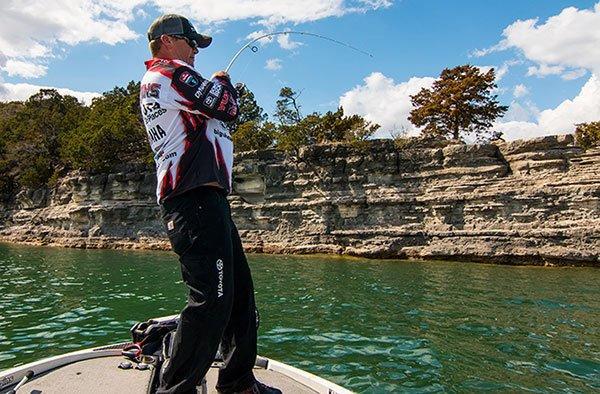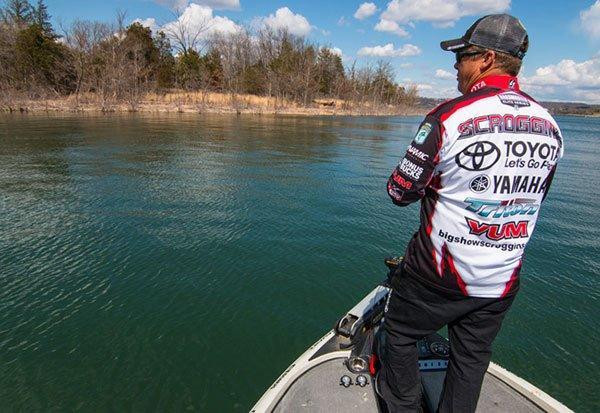Post-spawn bass fishing is widely considered a feast-or-famine season for many anglers. Gone are the days of expecting a bite on every obvious piece of cover; as the bass leave their more predictable shallow water haunts in search of deep structure, efficiency and continuous experimentation are indispensable.
Elite Series pro Terry Scroggins doesn’t let the nomadic nature of early summer post-spawn bass throw him for a loop. Throughout his career, he has developed 6 easy tips that will help you stay on top of the bass when other anglers tend to struggle.
Avoid fishing in the past
Most of us are creatures of habit—we tend to go to bed at the same time each night, wake up at the same time each morning and in a bass angler’s case, we’re often tempted to fish the same areas that have previously yielded big bass and fond fishing memories. If you can put your fishing “history” on the backburner, however, Scroggins believes you’ll be ahead of the game this season.
“This is an excellent time to catch big bass. They’ve been stressed out for the past several weeks and they want to fatten up. As they get schooled up and start feeding aggressively, you can have some ridiculous days on the water.”
“Post-spawn bass fishing is definitely a tricky time of year,” Scroggins said. “Once the bass wrap up the spawning process, they want to move to deeper structure as quickly as possible. This leaves anglers in a tough situation—we have to figure out a way to intercept them throughout their migration route. The fish move daily, which makes it extremely important to adapt each and every day you’re on the water.”
In other words—don’t be stubborn to a specific spot or pattern. Even if you caught a lot of nice bass in an area yesterday, those fish can move hundreds of yards overnight and be gone today.
“A lot of folks want to fish the spots that worked last week or even the previous day, but fishing history doesn’t work this time of year,” Scroggins said. “If your best areas don’t produce, always look for the next hard structure closer to deep water such as shell beds, rock piles or stumps and start your search there.”
Don’t overlook steep banks
Many types of bass fishing structure and cover are most productive on a seasonal basis, but Scroggins has found steep banks to offer outstanding fishing opportunities throughout the entire year. In the early summer months as the majority of bass make their annual trek to deeper water, they use these banks for several different reasons.
- Travel routes—“A steep bank, such as a bluff wall, is almost always indicative of a deep channel swing,” Scroggins said. “Bass are going to use the path of least resistance when coming in and out of spawning pockets and these channels allow them to move quickly and efficiently. So if you can find a tall, vertical bank, you have a great chance of intercepting some hefty post-spawners.”
- Forage—“When bass are done spawning, their energy levels are depleted,” Scroggins said. “They’ve had a one-track mind for the past several weeks and haven’t been feeding very much. As a result, post-spawners gorge themselves on shad and crawfish which are often found on steep banks. The shad also use the channels as migratory routes and the crawfish love the clay banks and small rocks often found in these areas.”
- Lowlight conditions—“If you’ve ever been swimming in a lake this time of year, you’ve probably noticed how the water temperature varies depending upon depth,” Scroggins said. “It may be a 90-degree surface temperature but your feet will be in 70-degree water. This makes lowlight conditions critical in these areas—the bass will move up in the water column and feed in the cool water, making them very easy to catch. As the day drags on and it gets warmer, they’ll slide off into deeper water to take advantage of the cooler temperatures.”
Keep your spinning gear nearby
Although finesse fishing has an unfair reputation for catching smaller fish, always make sure you load your spinning gear before you fish for post-spawn bass. Big females often require a period of recovery following the rigors of the spawn, making small, subtle presentations very effective.
“Before post-spawners start focusing on food, they can be fairly inactive for a short period,” Scroggins said. “The loud thump of a big crankbait and the large profile of a jig may not always be what they’re looking for, so don’t be afraid of spinning gear because it catches some really big fish in the early summer. I caught a 9-pound, 12-ounce bass on Toledo Bend a few years ago using 10-pound braid and with a 6-pound leader.”
Now, you probably won’t catch a 9-pounder each time you break out your spinning gear, but these finesse presentations will generate bites when other tactics fail. In a season when bass are constantly on the move, a few extra bites are all that’s needed to start putting together the daily post-spawn puzzle.
A solid dissection system
Time management is no more critical to your bass fishing success than it is right now. Getting out of rhythm and deviating from your game plan for just a few minutes can totally derail and otherwise perfect game plan.
- First things first—“A lot of people overlook the shad spawn this time of year,” Scroggins said. “You can absolutely load the boat in the first hour of daylight if you time it just right. Throw a white spinnerbait and keep a close eye on it as it comes back to the boat—if you see a bunch of shad following it and ticking the blades, you can rest assured there are bass in an area. It only lasts for the first few hours each day, so target rocks, grass and marina docks early in the morning and you’ll have a great chance of making something happen.”
- Mid to late morning—“You’re also going to notice a lot of bream beds in the early summer months,” Scroggins said. “These are outstanding places to catch your kicker fish. If you can’t smell them, look in the shallow bays for glowing white spots that look almost like sunken tires. Once you find ‘em, big bass in these areas are suckers for topwater frogs, swim jigs and bream-colored squarebills.”
- Lunchtime—“After I’ve taken advantage of the shad spawn and nearby bream beds, I’ll start to concentrate my efforts from the secondary points out to the mouths of creeks,” Scroggins said. “This is largely a run-and-gun type of deal. I’m going to hit every secondary I can find and if I don’t have any luck, I’ll start spending more time at the mouths of creeks”
- Afternoon—“When the sun gets high and the water really starts warming up, I’m going to hit the main channel and spend the rest of the day there,” Scroggins said. “This is where you’ll often find those mega-schools of bass. Focus on any irregularities on the channel ledges—these can be points, turns, doglegs, rocks or even logs. Anything that breaks up the monotony of a ledge will hold bass.”
Beware of the low-hanging fruit
Many of us are drawn to the bank whenever we go bass fishing. The laydowns, visual bank transitions and docks are tough to bypass, but Scroggins makes a concerted effort to steer clear of the distraction. His reasoning makes a lot of sense.
Want to learn more about these resident backwater bass? Check out our feature with Larry Nixon.
“On any body of water you’ll visit, there will be shallow fish,” Scroggins said. “There’s no doubt about it. But I like to find deep fish because I’m looking for schools—somewhere I can catch 40 bass several days in a row. Shallow fish can help you in the mornings, but try not to get too caught up with them.”
When you find shallow fish in the summer months, they’re more than likely considered “resident” fish, meaning they spend their entire lives in shallow water. They’re not too difficult to catch which can result in a fun day of fishing, but once you catch them—they’re gone. These areas don’t replenish like deep structure does, which can spell trouble for tournament anglers in a multi-day event.
Crank first, drag later
When fishing deep channel ledges later in the day, Scroggins begins by utilizing faster presentations before slowing down to “mop-up” the more lethargic bass with more deliberate techniques.
- Deep crankbait—“I’m almost always going to start out with a deep crankbait when I’m fishing ledges for post-spawners,” Scroggins said. “For whatever reason, I catch most of my big fish cranking—they have a hard time passing them up. This approach also allows me to cover water quickly and make the less aggressive fish react.”
- Big worm and football jig—“This is a great backup plan when the fish won’t each a big crankbait,” Scroggins said. “Both of these baits are still bulky and catch big fish, but they’re a little slower which can produce a lot of extra bites.”
- Drop shot and shaky head—“In a lot of reservoirs, the bass tend to be extremely current-oriented throughout the entire summer,” Scroggins said. “If you’re stuck fishing these ledges on a day with no water movement, don’t get discouraged—instead, rely on your finesse presentations. They will definitely still eat, but you might have to downsize your gear and coerce them into biting.”
Don’t let the finicky nature of post-spawn bass mess with your confidence this summer. If you can spend some extra time on the water and experiment in new places, target steep banks, get comfortable with spinning gear and develop a solid, systematic game plan, you’ll enjoy a lot of success and get a lot of satisfaction from your hard work.













